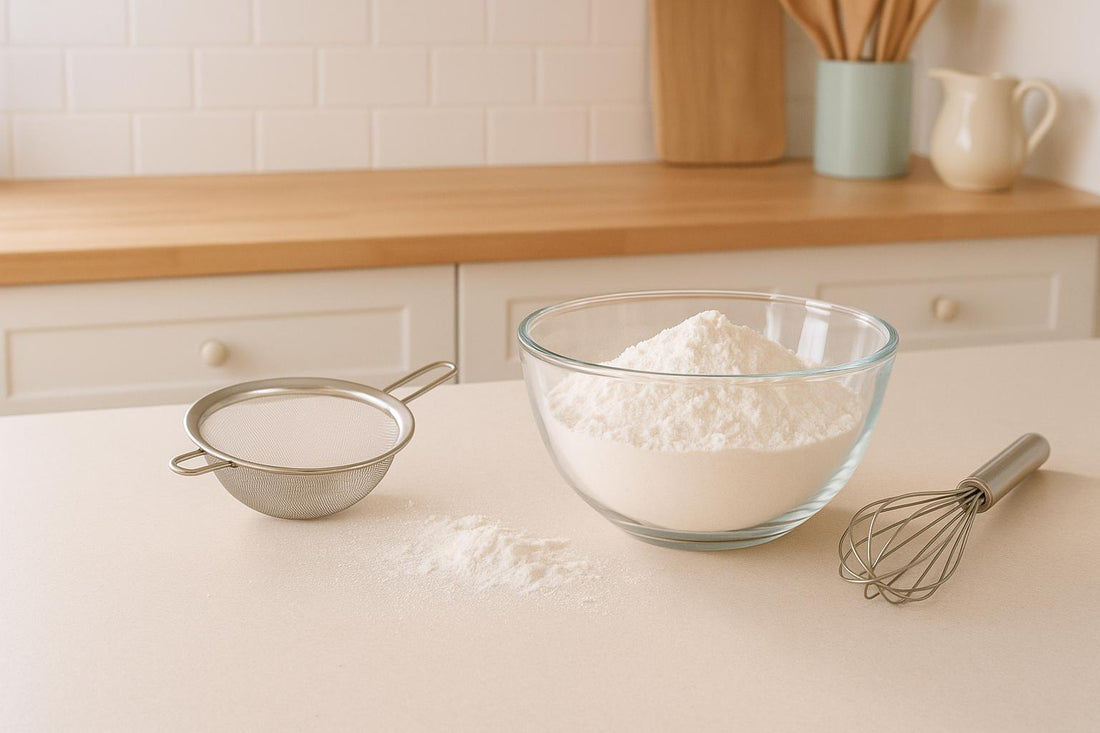
How to Sift Flour Without a Sifter
Share
No sifter? No problem. You can still sift flour using common kitchen tools to improve your baking. Sifting flour removes lumps, adds air, and ensures even mixing for lighter, fluffier baked goods. Here's how you can do it:
- Fine-Mesh Strainer: Place flour in a strainer over a bowl, then tap or shake to sift.
- Whisk: Stir flour briskly in a bowl to aerate and break clumps.
- Fork: Stir in circular motions to loosen minor clumps (less effective than other methods).
| Tool | Best For | Limitations | Effort Level |
|---|---|---|---|
| Fine-Mesh Strainer | Removing lumps, aerating | Slower for large amounts | Medium |
| Whisk | Quick aeration, mixing | Doesn't remove debris | Low |
| Fork | Breaking small clumps | Limited aeration, no filtering | High |
Pro Tip: Store flour in airtight containers to prevent clumps and weigh ingredients for precise results.
How to Sift Flour Without a Sifter | Baking Tips with Casa Gioia

Tools You Can Use Instead of a Flour Sifter
No flour sifter? No problem. You can still achieve the right texture and aeration for your baking projects with some simple kitchen tools. While sifting helps ensure your baked goods turn out light and fluffy, these alternatives can step in when a traditional sifter isn't available. Each method has its perks, so you can pick the one that suits your situation best.
How to Use a Fine-Mesh Strainer
A fine-mesh strainer is a great stand-in for a flour sifter. Its tiny holes can effectively remove lumps and add air to your flour. To use it, place the strainer over a bowl, add your dry ingredients, and gently tap or shake the strainer so the flour passes through. This method works especially well if your flour has been sitting in storage and has become compacted. It also helps filter out any unwanted particles. Just keep in mind that this approach requires both hands and can be a bit slow if you're working with larger amounts of flour.
Sifting Flour with a Whisk
If you're looking for a quicker option, grab a whisk. A whisk is perfect for aerating flour and mixing dry ingredients at the same time. Simply pour your flour into a large bowl and whisk it briskly. This method introduces air into the flour, giving it a lighter texture. However, it doesn't filter out debris or impurities, so it might not be the best choice if your flour needs extra refinement.
Using a Fork to Break Up Flour Clumps
In a pinch, a fork can get the job done, though it's less effective than the other methods. Use a fork to stir the flour in circular motions, breaking up clumps as you go. While this method can help loosen compacted flour, it won't aerate it much or remove impurities. A fork is best used when your flour is only slightly clumpy and your recipe doesn't demand a super-light texture.
| Tool | Best For | Limitations | Effort Level |
|---|---|---|---|
| Fine-Mesh Strainer | Removing lumps and adding aeration | Requires two hands; slower for large amounts | Medium |
| Wire Whisk | Quick aeration and mixing | Doesn't filter out debris | Low |
| Fork | Breaking up minor clumps | Limited aeration; doesn't remove debris | High |
How to Sift Flour Without a Sifter: Step-by-Step Methods
If you don’t have a traditional sifter on hand, don’t worry. There are simple ways to achieve the same result using common kitchen tools. Here’s how:
Strainer Method
Grab a fine-mesh strainer and place it over a bowl or a sheet of parchment paper. Pour the flour into the strainer, then gently tap the side to let the flour pass through. For any stubborn clumps, use a spoon to press them lightly - but avoid compressing the flour.
Whisking Method
Add your flour to a dry mixing bowl and whisk it briskly using quick, short motions. This will break up clumps and aerate the flour, making it lighter. It’s a great option if you’re combining other dry ingredients at the same time. [3, 16]
Fork Method
Place the flour in a large bowl and use a fork to stir it in fast, circular motions. Keep stirring until the flour becomes smooth and clump-free. While this method takes a bit longer, it’s a reliable backup when no other tools are available.
sbb-itb-c693c43
Tips for Better Flour Sifting Results
Building on the sifting techniques already covered, these tips can help refine your flour preparation even further. With a few adjustments, you can make alternative sifting methods work even better and achieve consistent results every time you bake.
How to Store Flour Properly
Proper storage is key to keeping your flour clump-free and ready for sifting. The way you store it can significantly impact how easily it sifts, making your baking process smoother.
Start by transferring your flour from its original paper bag into an airtight container as soon as you bring it home. Airtight plastic containers or glass jars are ideal for keeping moisture and air out, which can cause clumping.
Store the container in a cool, dark spot like your pantry, away from heat and direct sunlight. If you live in a humid area, toss a few grains of rice into the container to absorb excess moisture.
For longer storage, place your flour in the refrigerator for up to a year or in the freezer for extended periods. Keep in mind that specialty flours, like whole wheat or almond flour, spoil faster than all-purpose flour. If you’re using frozen flour, let it reach room temperature before opening the container to avoid condensation.
Why You Should Weigh Your Ingredients
Using a kitchen scale instead of measuring cups can make a huge difference in your baking, especially when paired with alternative sifting methods.
Here’s why: a cup of all-purpose flour can weigh anywhere from 3 to 5½ ounces depending on how it’s measured, but the ideal weight is about 4¼ ounces. That’s a potential 30% difference in weight - ranging from roughly 120 grams to over 150 grams.
"Unlike cooking, where measurements can be flexible, baking is a science and measurements need to be extremely precise. Even an extra ounce here or there can cause a baking fail."
– Lindsay D. Mattison, Taste of Home
Weighing your flour ensures accuracy, saves time, and reduces cleanup. Plus, it eliminates the guesswork, giving you more consistent results.
Mix Different Methods for Better Results
Once you’re comfortable with individual sifting tools, try combining methods for an even finer flour texture. Blending techniques can help incorporate more air and remove stubborn clumps better than relying on a single approach.
For example, start by whisking your flour in a bowl to break up obvious clumps and add air. Then, pass it through a fine-mesh strainer to catch any remaining lumps. The whisk aerates the flour, while the strainer gives it that final, smooth finish.
This approach works particularly well when mixing multiple dry ingredients. Combine your flour, baking powder, salt, and spices in a bowl first, whisk them together, and then sift the entire mixture to ensure everything is evenly blended and lump-free.
If you’re dealing with older or extra-stubborn flour, try a three-step process: break it up with a fork, whisk it, and finish by passing it through a strainer. While it takes a bit more effort, the improved texture is worth it for important baking projects.
Making Baking Easier Without a Flour Sifter
You don’t need a traditional flour sifter to whip up light and airy baked goods. With a few clever techniques, your kitchen can handle any recipe that calls for sifted flour.
Alternative Tools for Sifting
Different tools can deliver great results depending on your baking needs. A fine-mesh strainer is your best bet - it works much like a flour sifter, effectively removing lumps and aerating flour. If you don’t have one on hand, a wire whisk is another great option. By swirling it in quick, circular motions, you can fluff your dry ingredients and incorporate air, making your flour lighter and easier to mix. For smaller clumps, a fork can do the trick, though it’s not as effective at removing impurities. It’s best used alongside other methods or for flour that’s only slightly clumped.
Using these tools correctly ensures your baked goods turn out consistently light and fluffy.
Setting Up for Success in the Kitchen
Adopting alternative sifting methods is just part of the equation. Organizing your workspace can make your baking process even smoother. As Escoffier wisely said:
"Careful consideration of layout, planning, and efficiency can be the difference between a good baker or pastry chef and a great one".
A clean and well-organized kitchen is essential, especially when working with these alternative tools. The concept of mise en place - gathering all your tools and ingredients before you start - becomes even more critical here. Having everything ready means you won’t be scrambling to find a clean whisk or strainer mid-recipe.
For added convenience, consider investing in a quality apron like those from Cosmic Aprons. Their cotton aprons come with adjustable straps and handy pockets, making it easy to keep tools like measuring spoons or your phone within reach. This is especially useful when switching between sifting methods.
Finally, adopt a “clean as you go” habit. Wiping down surfaces and cleaning tools between steps prevents flour from building up and ensures your workspace stays ready for the next task. Store your flour in airtight containers to reduce clumps, and weigh your ingredients for accuracy. These small steps go a long way in delivering professional-level results, even without a traditional sifter.
FAQs
Why is a fine-mesh strainer better than a whisk or fork for sifting flour?
A fine-mesh strainer is an excellent choice for sifting flour because it does more than just separate clumps - it adds air to the flour. This extra aeration is key to creating light, fluffy baked goods, especially for recipes like cakes, where the texture and rise depend on properly sifted flour.
Compared to tools like a whisk or fork, a fine-mesh strainer is far better at removing lumps, giving you a smoother, more uniform consistency. This ensures the flour mixes seamlessly with other ingredients, making it a dependable and efficient tool for consistent baking results.
Why does proper flour storage matter when using alternative sifting methods?
Properly storing your flour plays a big role in making sifting easier, especially when you're using tools like a whisk, strainer, or fork. Keeping flour in a cool, dry spot and sealing it in airtight containers helps avoid moisture buildup, which is a common cause of clumping. And let's face it - clumpy flour can be a real hassle when you're trying to mix or aerate it evenly.
Humidity is often the main reason flour forms lumps, which can throw off your sifting game. By ensuring your flour stays fresh and free of clumps, you'll have a much smoother time incorporating it into recipes. Plus, good storage habits help preserve the flour's texture and quality, making your baking process that much easier.
Why is it better to weigh flour instead of using measuring cups when sifting without a sifter?
When it comes to baking, weighing flour is far more precise than using measuring cups. Measuring cups can lead to inconsistencies because the weight of a "cup" of flour can fluctuate - ranging from 4.25 to 5.6 ounces - depending on how tightly it's packed or scooped. These variations can significantly impact the texture and structure of your baked goods. By using a kitchen scale, you can measure the exact amount of flour needed every time, resulting in more reliable and consistent baking outcomes.
